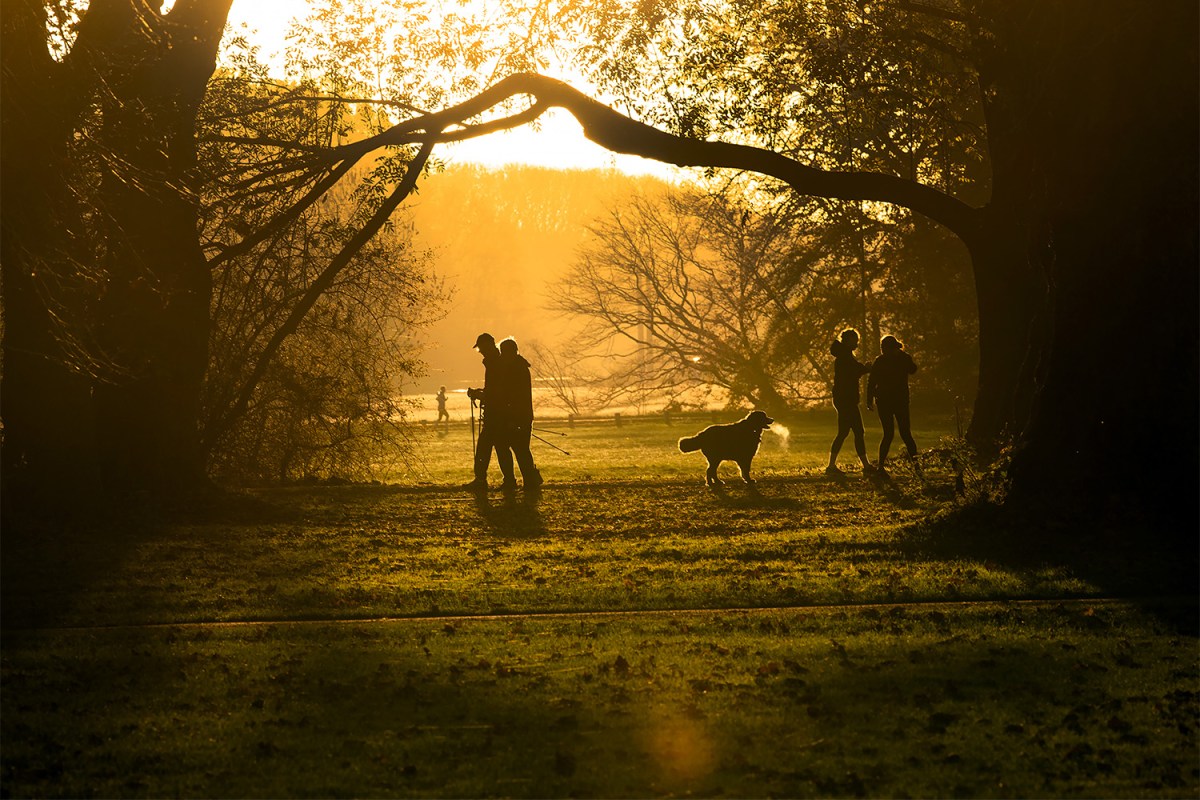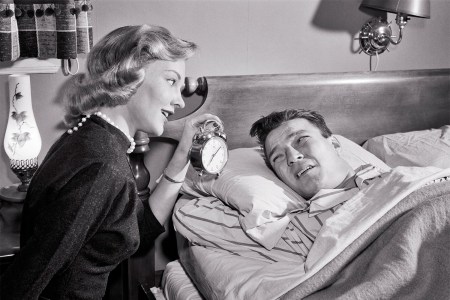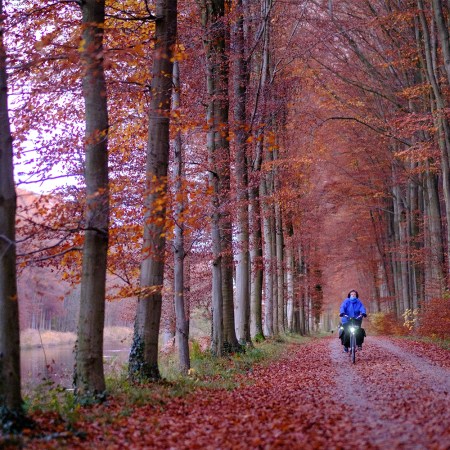Research suggests that morning sunlight keeps our daily biological cycles running smoothly, which helps ensure good sleep at night. This raised my interest because, like a streaky shooter in basketball, I’ve always been an unreliable sleeper: I sleep well for a few weeks and then, just when I think I can’t miss, my hot streak ends with three or four nights of staring at the ceiling.
Morning light seemed like a simple and promising strategy to bring more consistency to my slumber game. Light is the cue in the environment with the strongest effect on our bodies’ 24-hour cycles, or circadian rhythms. When looking at bright screens at night, we get the wrong signals and fall out of step with these rhythms. Over time, this increases the risk of chronic diseases like cancer. Conversely, when our “light diets” support our rhythms, we’re healthier and happier — light itself has an antidepressant effect. Plus, morning light exposure has shown improvements in deep sleep, overall sleep quality and clear thinking when awake.
After several months of sunnier mornings, I was shooting fewer bricks at night. However, I still had spells of insomnia. And the more I thought about it, my new AM ritual didn’t seem so simple. Especially this past winter, I started wondering if I was doing it wrong. My morning light morale was sinking, especially when my wife and eight-year-old son started making fun of me for huddling under our biggest blankets whenever there was snow on the ground.
So I talked with scientists who study circadian rhythms to learn if I was sleeping on the best approaches to getting morning light.
Your Last, Best Defense Before Sleep Divorce
In which we sing the unheralded praises of the “split king” bedHow Much Light Should We Get?
Mariana Figueiro, director of Mount Sinai’s Light and Health Research Center, has found that for the average person, the optimal duration of bright light is at least one to two hours. “I don’t think people understand how important it is to get light during the day,” she told me. “Preferably in the earlier part of the day.” If you’re struggling with sleep, Figueiro said, you’ll see a “very strong improvement.”
Researchers at Rush University discovered that a group of office workers receiving bright light for two hours in the morning was able to fall asleep earlier at night, compared to groups that got between 30 minutes and an hour of light. According to a separate paper last year, the magic number for improved sleep and next-day alertness is one-and-half hours of morning light.
Past a couple of hours, though, there may be diminishing returns. While a classic study out of Germany in 2003 concluded that sleep improved for each additional hour of bright light, the Rush researchers found “minimal gains” with over three hours of exposure. Cavort outside the whole day like a nomad if you like, but it’s not required for optimal sleep.
Individuals differ in their light sensitivity, so you’ll want to experiment to find your most effective “light diet.” Generally speaking, though, about 30 minutes should be beneficial; and if you really want to sleep like an underground armadillo, aim for about two hours.
When, Exactly?
Morning light will boost sleep the most when you get it right after waking up, said Dr. Brandon Peters, a sleep physician at Virginia Mason Medical Center. Ideally, the light should hit your face about 15-20 minutes after rising from bed.
Why? Well, we’re most sensitive to light that’s received close to the time your body reaches its lowest core temperature, which happens before waking up. Once outside in the morning, our corneas soak up light that goes to the back of the eyeballs, where it’s converted into signals that ride nerve bundles to the pit of your brain, home of the master circadian clock. The clock rings an alarm for the rest of your body to fully awaken, and it sets a timer for an equally strong nighttime signal, a melatonin spike that makes you sleepy a few hours after sundown.
Early morning light is like “eating lunch at a regular time to prepare your body to be hungry for dinner at a predictable time,” said Michael Grandner, director of the Sleep and Health Research Program at the University of Arizona.
What Does “Bright Light” Mean?
Ideally, bright light would consist of unobstructed morning daylight, which bestows up to 100,000 lux (the units for measuring the brightness of light). That’s compared to a paltry 100-200 lux from your typical lamp indoors. Even on an overcast day, rays leaking through clouds are more powerful than your measly bulbs. Although, wearing sunglasses outside may block too much bright light in the early morning. Clear prescription glasses are fine.
If you’ve got to be inside on a sunny day, stay upstairs and face a window. It should be bright enough there to set your circadian meter.
The perfect storm is when you’re stuck inside on a gloomy weather day. In this scenario, you’ll be deprived of light even if you’re glued to the window. Thankfully, technology has a brilliant solution: the light lamp. These devices are specially designed to shower you with bright light to help maintain your circadian rhythms.
The overall goal is for the brightness of your morning light to starkly contrast your light exposure at night. “You want to have a robust light-dark pattern,” Figueiro said. Estimate the amount of bright light you got in the morning, then subtract your light exposure in the evening. The larger the difference, the better you’ll probably sleep, depending on other factors like your stress levels.
What if you typically wake up before sunrise? Tech is useful here, too. “If sunrise is well after your necessary wake-time,” Peters advised, “a light box would be most helpful.” Get some electric light first, then step under the brightening sky.
How Do I Fit Light Into My Busy Morning?
Make morning light part of your routine by combining it with other daily activities. I’m a meditator, so I do an open-eye meditation on my patio as the sun comes up, anchoring to the birdsong and sunlit clouds. I’m also a coffee addict, so I drink it outside while watching sports replays on my laptop. By putting the computer on a box in my lap, the screen is high enough that my face is angled toward the sunlight. Compared to some other health prescriptions, this one is actually pleasurable, a real highlight of my morning, even on cold winter days.
Many inside activities could just as easily happen outside. You’ve got to get to the office, so if you can, walk or cycle there instead of indoor transit. You’ve got to brush your teeth, so do it outside in the morning hours. If the neighbors see and judge you, shrug it off knowing you’ll sleep better than them.
It’s also convenient that you don’t have to get two hours all one sitting. Lab research shows that intermittent bright light is almost as good as continuous exposure.
What If I Miss a Day?
Bright light is especially effective when you’re exposed every day around the same times, according to a University of Basel review. You want to get locked into a consistent pattern. However, there can be exceptions. Evolution ensured that our biological clocks are robust enough that they won’t shift after only one cloudy day. A few dark days in a row will be more of a problem.
Where Should I Look?
For you overachievers, don’t try maxing out your morning light by looking at the sun. This will roast your retinas. Just “let the light bathe your face while averting your gaze elsewhere,” Peters said. Looking ahead on a clear day will net about 10,000 lux. That’s plenty. Gazing skyward on a sunny day will bump that number to 100,000, which, Grandner noted, is excessive and potentially harmful.
How About the Rest of the Day?
In addition to the morning, try to get outside in the early-to-mid-afternoon if you can, Figueiro advised. If you’re outside the whole morning and then disappear into your closet the rest of the day, your perplexed circadian timer may set too early, leading to a 3 a.m. wakeup the next day. This tip was a breakthrough for me. My sleep has improved since I routinized early morning bright light alongside an hour of afternoon exposure. The combo may work for you, too.
Next step: get my wife and eight-year-old out there with me.
The Charge will help you move better, think clearer and stay in the game longer. Subscribe to our wellness newsletter today.























